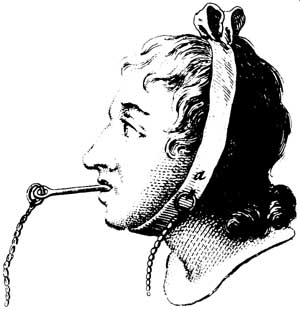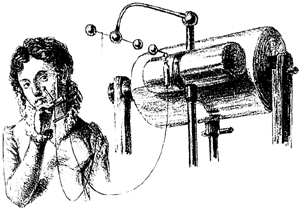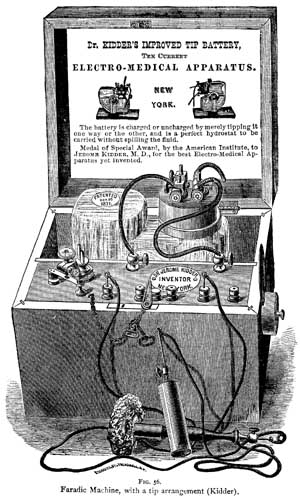
The dentist has been one of humanity's enduring bogeymen. Against the pain of toothache the solaces of strong drink, morphia, and philosophy alike prove useless. Drink and drugs dull the mind and senses; philosophy works only when you have a clear head. Alas, a head with an aching tooth is never clear! Dentists offered to convert nagging, chronic pain into acute agony, followed by healing. The choice -- more pain now for blessed relief later -- could hurt as much as the tooth itself.
Ancient physicians had many ways to relieve pain, all with side effects. Cold, or pressure on a nerve or artery, could numb a limb; overdone, they could paralyze or worse. Henbane, hemlock, mandrake and aconite could dull pain; but potencies varied, and all were poisonous in overdose. Alcohol, opium, and hashish were excellent and enjoyable anodynes, but lost effect in the long run. Worse, a poor sufferer could end up with addiction added to the toothache. (Seeman, ch 2)
Head pains are hardest of all to deal with. The nerve impulses have only a short way to travel, offering few opportunities for the physician to block them. Pressure often makes them worse. Cold may help headache but is of no use against toothache. Drugs muddle thinking. Only direct intervention at the source of pain offers much hope. About 2250 BC, a Mesopotamian physician suggested henbane seeds ground into a powder and mixed with gum mastic. This was then worked into the cavity -- and the henbane was able to exert a powerful localized numbing effect while causing few systemic problems. (Seeman, p 30) Today's drugstores still sell clove oil for application to decayed teeth.
In A.D. 46, the Roman physician Scribonius Largus recommended a new treatment for pain:
Headache even if it is chronic and unbearable is taken away and remedied forever by a live black torpedo placed on the spot which is in pain, until the pain ceases. As soon as the numbness has been felt the remedy should be removed lest the ability to feel be taken from the part. Moreover several torpedoes of the same kind should be prepared because the cure, that is the torpor which is a sign of betterment, is sometimes effective only after two or three.
The black torpedo is one of the electric fishes, with a 50 volt discharge and a peak power output of 1 kilowatt.(Hoar & Randall, p 372) Live torpedoes, taken from the sea, come wet with saline solution for a low-resistance connection. We can consider Scribonius' remedy to be electroshock therapy or TENS stimulation for pain -- after 2000 years, both remain in use.
Many years and a Dark Age later, people learned to do what comes naturally to a humble fish: make electricity in quantity. Francis Hauksbee the Elder invented an electrostatic generator in 1705. The chief uses of this new electricity were in entertainment and medicine. One of the earliest expressions of this was given by Johann Gottlob Krüger of the University of Halle in 1743. Students asked him for his thoughts on the new wonder of electricity. He replied, "... all things must have a usefulness; that is certain. Since electricity must have a usefulness, and we have seen that it cannot be looked for either in theology or in jurisprudence, there is obviously nothing left but medicine." (Licht, p 5) By 1770, electricity had enlisted in the war against pain. Ferguson reported,
"A woman, who complained much of a pain in her stomach, came to me to be electrified. --- I gave her only one shock across the stomach, and the pain immediately left her. But, on the next day, she came and told me, I had driven the pain from her stomach into one of her teeth, so that she was almost mad by the toothache. --- I then gave her a strong shock through her tooth and gum ... on which the toothache directly left her. I saw her about a week afterward, and she told me that she was quite well, and had no return of her late cause of complaint. --- I have tried the like experiment on many others since, who were afflicted with the tooth-ache, and it failed only with three; in one of whom I observed the tooth was much spoiled and decayed."
Electrical Treatment of Toothache, 1786

Charles Bew, surgeon-dentist to George IV of England, felt that tic douloureux (an extremely painful condition) was chiefly caused by dental problems. He recommended removal or modification of the defective tooth, or correction of the articulation of the jaw. He used supportive electrotherapy to help manage the pain, with powerful electric shocks from an electrostatic generator and Leyden Jar capacitor.

Bew's treatment for tic douloureux, 1824
Electrostatic machines gave powerful single pulses. Many people felt that getting all their electrotherapy in one instantaneous blast was little better than the pain it drove away. When the induction coil was invented, medicine had a gentler source which gave a rapid, continuous train of smaller pulses quite like the output of a modern TENS stimulator. Tripier noted that
"M. Francis (of Philadelphia) has announced that Faradization of teeth renders their extraction infinitely less painful, after assessing the results of a large number of trials of this method of anesthesia. A dentist of Geneva recommends attaching the dental key or forceps to the negative lead of a medical induction coil, while the patient holds the positive electrode in his hand. The tooth should be extracted immediately after the application of the electrified forceps."

Medical coil
The 1970 Desenor was a high-speed handpiece which carried a low-voltage electric current through the bur directly onto the tooth being treated. Almost as rapidly as the item was introduced into the market, the lack of enthusiasm among dentists led to its demise. (Malamed & Joseph) But this modern revival of Faradization faced stiffer competition than M. Francis (of Philadelphia) did. An old pain-reliever had come back into prominence.
One of the earliest operations in human history is trepanning. Such surgery was performed successfully perhaps 42,000 years ago. As far as can be reconstructed from the evidence of operations performed by the pre-Inca Indians of the Andes, the patient sat with his head held firmly between the knees of the witch doctor, who chewed coca leaves. Using a sharp stone knife as a chisel and a heavier stone as a mallet, a hole could be worked through the skull in a relatively short time. Throughout the course of this operation, the doctor would allow the juices of the coca leaf to drip onto the area of the incision, and this pain-relieving alkaloid would produce local anesthesia. This drastic treatment for headache was not only widely practiced, but had a remarkably high rate of recovery considering the circumstances. (Seeman, pp 22-23)
Coca -- source of cocaine, progenitor of our most effective modern local anesthetics including the novocaine so beloved of dentists and their patients. Purify the alkaloid, invent the hypodermic syringe to get it to the nerve, (Seeman, p 125) and we have the triumph of ancient pharmacology against acute pain.
Aspirin and friends may help, but for some chronic pain it's hard to beat electricity. TENS stimulation can take the edge off the pain without taking the edge off the mind and senses; and it is not addictive. The alcoholic's jolts must get stronger and stronger to ward off pain; but the user of TENS has little temptation to strengthen the jolt.
References:
Bertholon, de l'électricité du corps humaine ... (Paris, 1786)
Bew, Charles, Opinions on ... tic douloureux (London, 1770)
Ferguson, James, An introduction to electricity (London, 1770)
Hoar, W.S. and Randall, D.J. (eds) Fish Physiology (New York, 1971)
Licht, Sidney, Therapeutic electricity and ultraviolet radiation (Baltimore, 1967)
Malamed, Stanley F. and Joseph, Charles, "Electricity in dentistry" Jour. Calif. Dental Assn (Vol. 15 no. 6, June 1987)
Scribonius Largus, Compositiones Medicae XI as quoted in Kellaway, Peter, "The part played by electric fish in the early history of bioelectricity and electrotherapy" Bull. Hist. Med. 20 (1946): 112-137
Seeman, Bernard, Man Against Pain (Philadelphia, 1962)
Tripier, A., Manuel d'électrotherapie ... (Paris, 1861) (tr. by E. Kuhfeld)